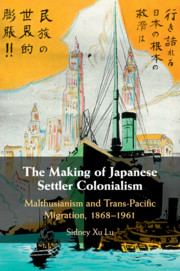Illustrations
Figures
I.1Map illustrating the sizes of Japanese overseas communities around the Pacific Rim
1.1A reprint of The Landing of the Pilgrim Fathers, Hokkaido Kaitaku Zasshi
1.3Hokkaido Kaitaku Zasshi introducing different types of salmon in Hokkaido
1.4A new wheat-cutting tool in the United States, Hokkaido Kaitaku Zasshi
1.5Native Americans in a guidebook for Japanese migration to the United States
2.1“Conflict of races” among the Caucasians, the Chinese, and the Japanese
2.2Map depicting the location of Hawaiʻi at the center of the sea route connecting Japan and the American West Coast
2.5Map depicting Japanese expansion to the South Seas and Latin America
3.1Magazine cover celebrating Japan’s victory in the Sino-Japanese War
5.1Members of an American congressional committee investigating the Japanese picture brides
5.2Japanese immigrants in Brazil harvesting cotton in the field
5.3Hundreds of bags of rice produced by Japanese immigrants in the state of São Paulo
5.4Kaikō poster from around the mid-1920s to recruit Japanese for Brazilian migration
5.5Magic lantern slide depicting the family of Nakamura Sadao
6.1Cartoons highlighting Brazil as the ideal place for surplus people in Japan
6.2Map illustrating the standard sea route for Japanese migration to Brazil in the 1920s
7.1The six prefectures that exported the largest numbers of migrants to Manchuria
7.2Map marking the land prices of different states in Brazil
7.3Cartoon promoting the slogan of coexistence and coprosperity (Kyōzon Dōei) as a spirit of the Producer’s Cooperative Association
7.4Front cover of the inaugural issue of Ie no Hikari, May 1925
7.5Cover of a brochure for the migration of Japanese owner-farmers to Brazil, March 1932
8.1World map recalculating the land sizes of major countries and continents based on the sizes of their populations
C.1Display board at the Overseas Migration Museum in Yokohama
C.2Section of the exhibition “We Join the New World” titled “Toil in the Soil”
Tables
5.1Annual numbers of Japanese migrants to Brazil and Manchuria in comparison (1932–1939)
6.1Comparison between the size of arable land and population among the countries of the world in 1924
6.2Comparison of Japanese migration to Brazil, the continental United States, and Hawaiʻi, 1906–1941
8.1Government-subsidized Japanese migration to Brazil, 1955–1965

